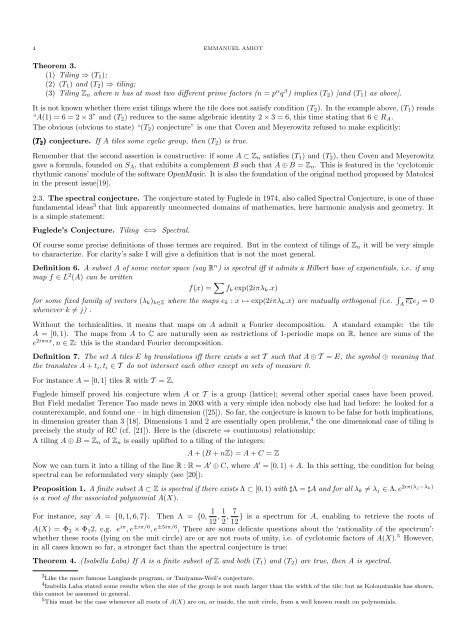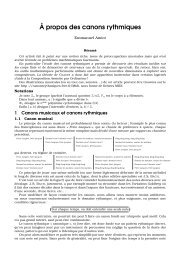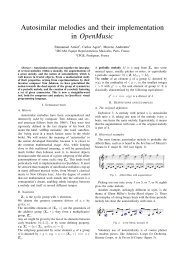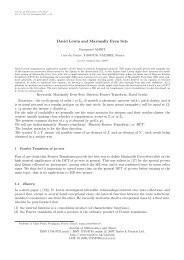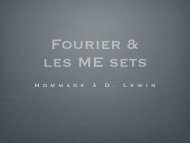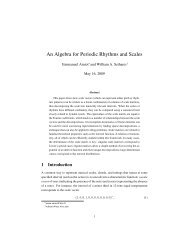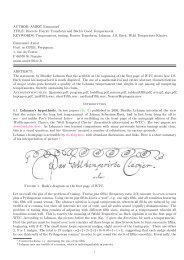Emmanuel Amiot Modèles algébriques et algorithmes pour la ...
Emmanuel Amiot Modèles algébriques et algorithmes pour la ...
Emmanuel Amiot Modèles algébriques et algorithmes pour la ...
Create successful ePaper yourself
Turn your PDF publications into a flip-book with our unique Google optimized e-Paper software.
4 EMMANUEL AMIOT<br />
Theorem 3.<br />
(1) Tiling ⇒ (T1);<br />
(2) (T1) and (T2) ⇒ tiling;<br />
(3) Tiling Zn where n has at most two different prime factors (n = p α q β ) implies (T2) [and (T1) as above].<br />
It is not known wh<strong>et</strong>her there exist tilings where the tile does not satisfy condition (T2). In the example above, (T1) reads<br />
“A(1) = 6 = 2 × 3” and (T2) reduces to the same algebraic identity 2 × 3 = 6, this time stating that 6 ∈ RA.<br />
The obvious (obvious to state) “(T2) conjecture” is one that Coven and Meyerowitz refused to make explicitly:<br />
(T2) conjecture. If A tiles some cyclic group, then (T2) is true.<br />
Remember that the second assertion is constructive: if some A ⊂ Zn satisfies (T1) and (T2), then Coven and Meyerowitz<br />
gave a formu<strong>la</strong>, founded on SA, that exhibits a complement B such that A ⊕ B = Zn. This is featured in the ‘cyclotomic<br />
rhythmic canons’ module of the software OpenMusic. It is also the foundation of the original m<strong>et</strong>hod proposed by Matolcsi<br />
in the present issue[19].<br />
2.3. The spectral conjecture. The conjecture stated by Fuglede in 1974, also called Spectral Conjecture, is one of those<br />
fundamental ideas 3 that link apparently unconnected domains of mathematics, here harmonic analysis and geom<strong>et</strong>ry. It<br />
is a simple statement:<br />
Fuglede’s Conjecture. Tiling ⇐⇒ Spectral.<br />
Of course some precise definitions of those termes are required. But in the context of tilings of Zn it will be very simple<br />
to characterize. For c<strong>la</strong>rity’s sake I will give a definition that is not the most general.<br />
Definition 6. A subs<strong>et</strong> A of some vector space (say Rn ) is spectral iff it admits a Hilbert base of exponentials, i.e. if any<br />
map f ∈ L2 (A) can be written<br />
f(x) = fk exp(2iπλk.x)<br />
for some fixed family of vectors (λk)k∈Z where the maps ek : x ↦→ exp(2iπλk.x) are mutually orthogonal (i.e. <br />
A ekej = 0<br />
whenever k = j) .<br />
Without the technicalities, it means that maps on A admit a Fourier decomposition. A standard example: the tile<br />
A = [0, 1). The maps from A to C are naturally seen as restrictions of 1-periodic maps on R, hence are sums of the<br />
e 2iπnx , n ∈ Z: this is the standard Fourier decomposition.<br />
Definition 7. The s<strong>et</strong> A tiles E by trans<strong>la</strong>tions iff there exists a s<strong>et</strong> T such that A ⊕ T = E, the symbol ⊕ meaning that<br />
the trans<strong>la</strong>tes A + ti, ti ∈ T do not intersect each other except on s<strong>et</strong>s of measure 0.<br />
For instance A = [0, 1] tiles R with T = Z.<br />
Fuglede himself proved his conjecture when A or T is a group (<strong>la</strong>ttice); several other special cases have been proved.<br />
But Field medalist Terence Tao made news in 2003 with a very simple idea nobody else had had before: he looked for a<br />
counterexample, and found one – in high dimension ([25]). So far, the conjecture is known to be false for both implications,<br />
in dimension greater than 3 [18]. Dimensions 1 and 2 are essentially open problems, 4 the one dimensional case of tiling is<br />
precisely the study of RC (cf. [21]). Here is the (discr<strong>et</strong>e ⇒ continuous) re<strong>la</strong>tionship:<br />
A tiling A ⊕ B = Zn of Zn is easily uplifted to a tiling of the integers:<br />
A + (B + nZ) = A + C = Z<br />
Now we can turn it into a tiling of the line R : R = A ′ ⊕ C, where A ′ = [0, 1) + A. In this s<strong>et</strong>ting, the condition for being<br />
spectral can be reformu<strong>la</strong>ted very simply (see [20]):<br />
Proposition 1. A finite subs<strong>et</strong> A ⊂ Z is spectral if there exists Λ ⊂ [0, 1) with ♯Λ = ♯A and for all λk = λj ∈ Λ, e 2iπ(λj−λk)<br />
is a root of the associated polynomial A(X).<br />
For instance, say A = {0, 1, 6, 7}. Then Λ = {0, 1 1 7<br />
, , } is a spectrum for A, enabling to r<strong>et</strong>rieve the roots of<br />
12 2 12<br />
A(X) = Φ2 × Φ12, e.g. e iπ , e ±iπ/6 , e ±5iπ/6 , There are some delicate questions about the ‘rationality of the spectrum’:<br />
wh<strong>et</strong>her these roots (lying on the unit circle) are or are not roots of unity, i.e. of cyclotomic factors of A(X). 5 However,<br />
in all cases known so far, a stronger fact than the spectral conjecture is true:<br />
Theorem 4. (Isabel<strong>la</strong> ̷Laba) If A is a finite subs<strong>et</strong> of Z and both (T1) and (T2) are true, then A is spectral.<br />
3Like the more famous Lang<strong>la</strong>nds program, or Taniyama-Weil’s conjecture.<br />
4Izabel<strong>la</strong> ̷Laba stated some results when the size of the group is not much <strong>la</strong>rger than the width of the tile; but as Kolountzakis has shown,<br />
this cannot be assumed in general.<br />
5This must be the case whenever all roots of A(X) are on, or inside, the unit circle, from a well known result on polynomials.


